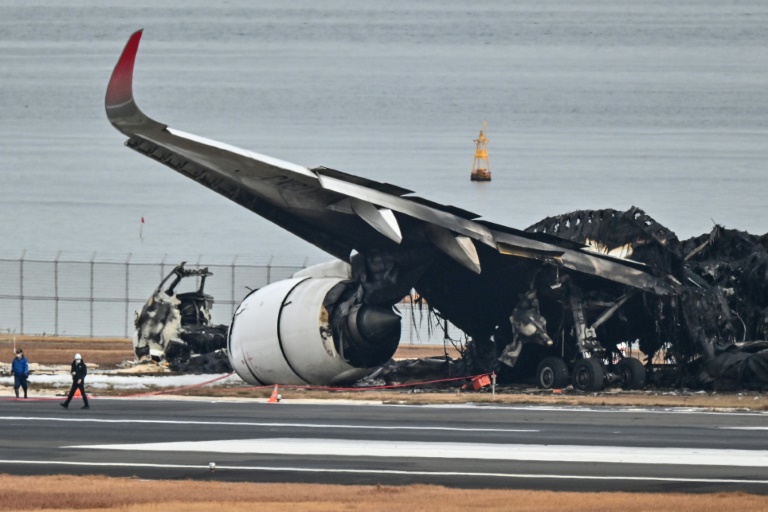The ‘textbook’ evacuation from Japan jet inferno

A carefully rehearsed and executed evacuation that stopped the plane turning into a death trap, experts said – Copyright AFP Richard A. Brooks
Hiroshi HIYAMA, Etienne BALMER
After landing, smoke filled the cabin and flames licked the windows, but the Japan Airlines crew got all 367 passengers safely off the aircraft in an orderly fashion — and just in time.
Babies and children screamed and panic-stricken passengers begged to be let off, footage from the scene on Tuesday at Tokyo’s Haneda Airport showed.
“Honestly, I thought we wouldn’t survive. So I texted my family and friends to say that my plane is burning, right now,” a woman told broadcaster NHK.
After arriving from Hokkaido in the north, the Japan Airlines Airbus collided with a coast guard plane and caught fire as it sped down the runway.
It careened to a halt after the front landing gear failed, but all 379 passengers and crew managed to escape down two emergency slides before the plane was engulfed in flames.
The smaller coast guard vessel was heading to deliver aid to earthquake-hit central Japan. Five of the six personnel died.
Those on board JAL’s Airbus liner feared that could have been their fate.
“It felt like we abruptly hit something. Then the fire started, like, ‘bang!’” a male passenger told broadcaster TBS.
“The smell of smoke was in the air, and the doors were not opening. So I think everyone panicked,” a woman told reporters at the airport.
Eight children were on board the passenger plane. In one video clip, a young voice can be heard shouting: “Please let us out. Please. Please open it. Just open it. Oh, god.”
– ‘Evacuating promptly and efficiently’ –
The plane landed at 5:46 pm (0846 GMT) and everyone was off just under 20 minutes later, Japan Airlines told a briefing on Tuesday night.
Aviation experts said it was a carefully rehearsed and executed evacuation that stopped the plane from turning into a death trap.
“Passengers seemed to have followed instructions in a textbook manner,” Terence Fan, an airline industry expert from Singapore Management University told AFP, with others praising those on board for leaving their cabin bags behind.
“This is exactly what evacuation policies are designed for — the airframe itself is not meant to survive the blaze, ultimately.”
David Kaminski-Morrow, air transport editor at aviation news website FlightGlobal said: “I wouldn’t personally call the successful evacuation of the JAL flight a ‘lucky escape’, although the passengers might believe so.”
Instead, he added, an efficient evacuation showed “what can be achieved by evacuating promptly and efficiently”.
Passenger William Manzione told Sky News that “everything was really quick”.
“When I saw the inflatable slide, I understood this was bad. I took my son … Then I turned around and saw the aeroplane with the nose completely smashed and the flames all over the back,” he said.
After 10 minutes on the tarmac, the flames had spread and a loud noise, like at take-off, came from one of the engines.
“That was the biggest moment of fear for me and the other passengers, because the feeling was like, ‘this is about to explode’,” he said.
“The crew in that moment start shouting to run altogether away from the airplane, (but) eventually nothing happens, so it’s good.”
Other emotional footage showed a mother waiting for her teenage son who was on the plane, rushing to hug him when he emerged.
And a young boy expressed his relief and gratitude to the cameras: “To people at JAL and to God, I want to say thank you so much.”
The ‘textbook’ evacuation from Japan jet inferno
#textbook #evacuation #Japan #jet #inferno





